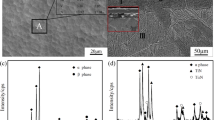Abstract
In order to improve the wear resistance of titanium alloys, the potential of the plasma nitriding process with a cathode assiting discharge setup was examined. Ti6Al4V alloy was nitrided by the cathode assiting discharge nitriding (CAN) and conventional DC plasma nitriding (CPN) methods, respectively. The micro-topography, phase composition and cross-sectional microhardness distribution of two nitriding layers were studied comparatively. The sliding wear resistance of the nitriding layers was examined by a ball-on-disk test against Si3N4 balls. The results indicated that the surface roughness Ra of the CAN layer was about 1 order less than that of the CPN layer. In addition, the CAN surfaces possessed significantly greater wear resistance than the CPN layer at higher loads, and increased the wear resistance of Ti6Al4V alloy by about 2 orders due to the higher loading bearing ability, higher rate of TiN phase, greater surface microhardness and bigger microhardness improving depth. This is because the double glow discharge effect in CAN strengthened the density of the active nitrogen atoms and the nitriding efficiency. Moreover, the ion bombardment effect on the surface of the nitriding titanium alloy was reduced obviously.
Similar content being viewed by others
References
Mishra S C, Nayak B B, Mohanty B C, et al. Surface nitriding of titanium in arc plasma. J Mater Proc Technol, 2003, 132: 143–148
Man H C, Cui Z D, Yang X J. Characterization of the laser gas nitrided surface of NiTi shape memory alloy. Appl Surf Sci, 2002, 199: 388–393
Banfield S, Avelar-Batista Wilson J C, Cassar G, et al. An investigation into the effect of Triode Plasma Oxidation (TPO) on the tribological properties of Ti6Al4V. Surf Coat Technol, 2011, 206: 1955–1962
Bekir S Y, Ahmet Z S, Ahmed Z A, et al. Plasma nitriding of Ti6Al4V alloy to improve some tribological properties. Surf Coat Technol, 1996, 80: 287–292
Nishimoto A, Nagatsuka K, Narita R, et al. Effect of the distance between screen and sample on active screen plasma nitriding properties. Surf Coat Technol, 2010, 205: 365–368
Michel H, Czerwiec T, Gantois M, et al. Progress in the analysis of the mechanisms of ion nitriding. Surf Coat Technol, 1995, 72: 103–111
Meletis E I, Cooper C V, Marchev K. The use of intensified plasma-assisted processing to enhance the surface properties of titanium. Surf Coat Technol, 1999, 113: 201–209
Petrov G M, Zhechev D. Electron energy distribution function and electron characteristics of conventional and micro hollow cathode discharges. Phys Plasmas, 2002, 9(5): 1815–1818
Alves C, Guerra Neto C L B, Morais G H S, et al. Nitriding of titanium disks and industrial dental implants using hollow cathode discharge. Surf Coat Technol, 2005, 194: 196–202
Singh G P, Alphonsa J, Barhai P K, et al. Effect of surface roughness on the properties of the layer formed on AISI 304 stainless steel after plasma nitriding. Surf Coat Technol, 2006, 200: 5807–5816
Xu Z. US Patent 4520268 and 4731539, UK Patent 2150602, Austria Patent 580734, Canada Patent 1212486, Sweden Patent 8500364-8
Zhan K, Qu J Z, Chen Z Y, et al. Influence of plasma nitriding technics parameter on the substrate of TC4 modified layer thickness. Phys Testing Chem Anal Part A-Phys Test, 2008, 44: 5–8
Waite M M, Ismat Shah S. Target poisoning during reactive sputtering of silicon with oxygen and nitrogen. Mater Sci Eng, 2007, 140: 64–68
Combadiere L, Machet J. Study and control of both target-poisoning mechanisms and reactive phenomenon in reactive planar magnetron cathodic sputtering of TiN. Surf Coat Technol, 1996, 52: 145–157
Zhecheva A, Sha W, Malinov S, et al. Enhancing the microstructure and properties of titanium alloys through nitriding and other surface engineering methods. Surf Coat Technol, 2005, 200: 2912–2917
Adjaottor A A, Ma E, Meletis E I. On the mechanism of intensified plasma-assisted processing. Surf Coat Technol, 1997, 89: 197–203
Xu Z, Liu X, Zhang P, et al. Double glow plasma surface alloying and plasma nitriding. Surf Coat Technol, 2007, 201: 4822–4825
Author information
Authors and Affiliations
Corresponding author
Rights and permissions
About this article
Cite this article
Tang, J., Liu, D., Tang, C. et al. Surface modification of Ti-6Al-4V alloy by cathode assiting discharge setup and conventional plasma nitriding methods. Sci. China Technol. Sci. 56, 1858–1864 (2013). https://doi.org/10.1007/s11431-013-5252-z
Received:
Accepted:
Published:
Issue Date:
DOI: https://doi.org/10.1007/s11431-013-5252-z




